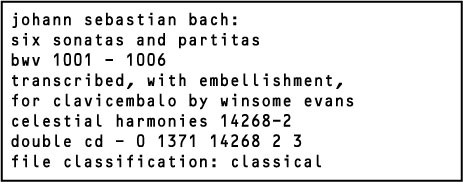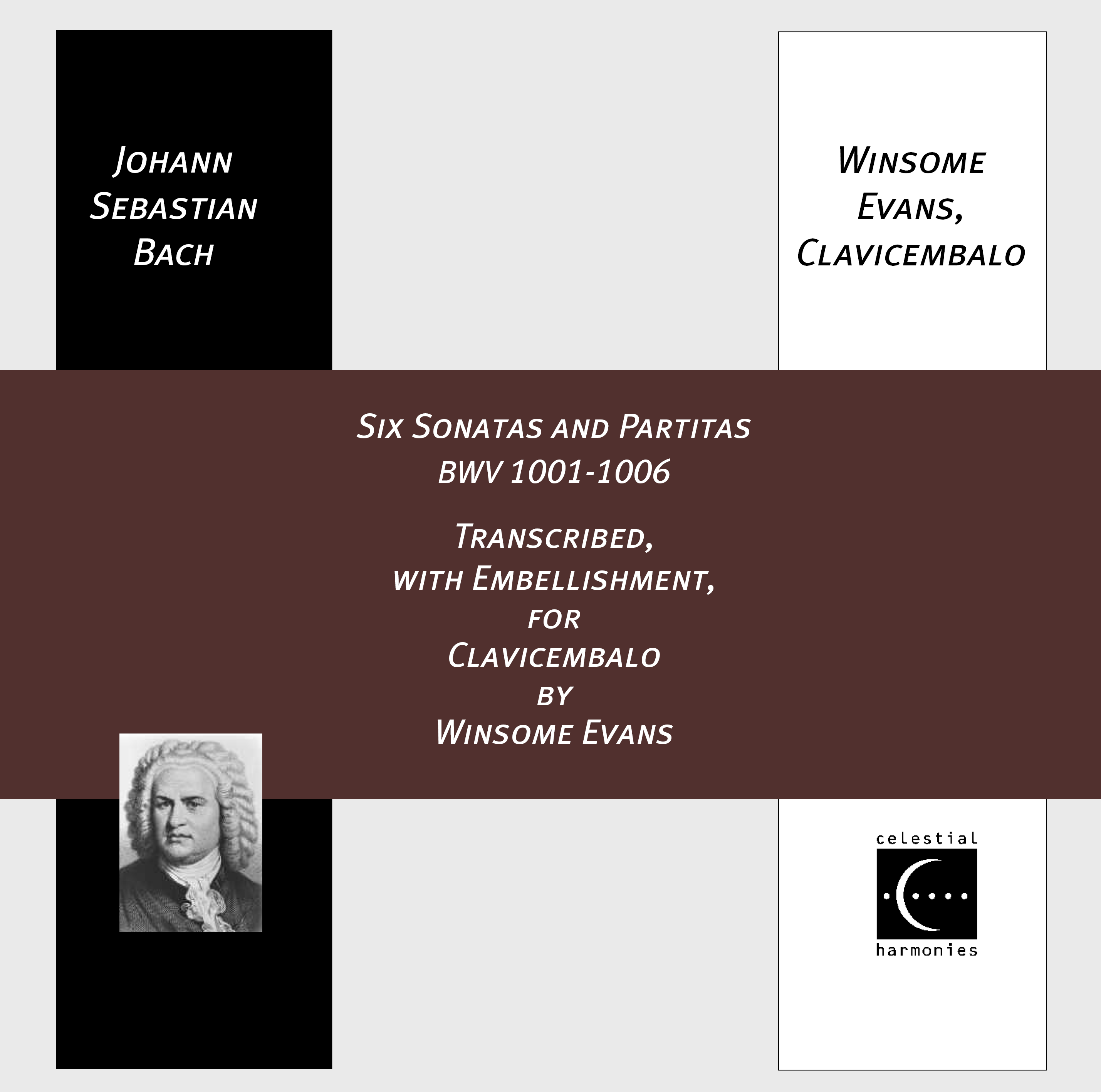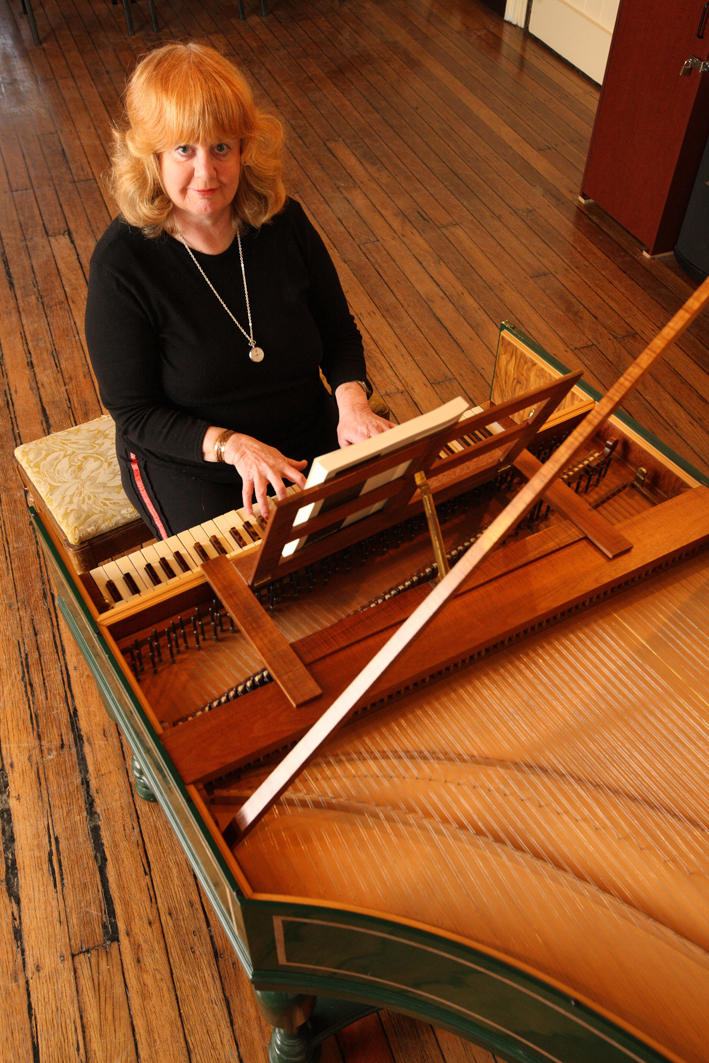 |
||||||||||||||||||||||||||||||||||||||||||||||||||||||||||||||||||||||||||||||||||||||||||||||||||||||||||||||||||||||||||||||
 
Following a custom common at the time, Johann Sebastian Bach was, throughout his life, a prolific transcriber and rearranger of his own and his contemporaries' compositions. The music on these recordings should not be classified simply as arrangement, and certainly not as interpretation, but rather as translation, or metamorphosis, from one medium (unaccompanied solo violin) to another (solo harpsichord) with Bach himself as the only model. The aim here has been, firstly, to create a body of music which is suitable for the harpsichord, the keyboard instrument Bach preferred for his own transcriptions and, secondly, to model its components on the textures, the compass range, the harmonic, contrapuntal and rhythmic procedures which Bach used in his various transcriptions, as well as in his large-scale works for the harpsichord. The third aim was to perform these transcriptions/transformations with the ornamentation and embellishment (graces and passage work), the fingering, the articulation and registrations of his style, in the manner of his time. Bach's music is always polyphonic, whereas the violin, by nature, is not. Winsome Evans's idea was that Bach's music is originally abstract/theoretical music existing in a space without instrumentation to begin with. She wanted to bring out what in her belief was the full character of the pieces—the bass lines, voices and embellishment had to be added to what was thought to have been multi-layered music in Bach's mind at the outset. The score is the result of this effort, and Winsome Evans's own recording should be considered as just the beginning of the process of breathing new life into the works. It should be noted that Bach was a violinist himself, and that he acted responsibly and in his own best interest when he issued the six works as he did. Nevertheless, there is an open character to be taken for granted in Bach's entire body of works, allowing for different views and interpretations (and additions as it were). After all, Bach's works have a long history of being adapted and rearranged, which has mostly turned out to be a good thing. From Ferrucio Busoni to Switched-On Bach, the Swingle Singers to Glenn Gould or the Modern Jazz Quartet, no Western classical composer has inspired—for better or worse—so many different approaches over the past century, since recording has allowed us to know what people are doing. This double CD recording and pocket score (206 pages incl. a facsimile of the 1720 autograph) are also presented in an attractive black box (14268-5). The performance score is also available upon request from Celestial Harmonies. the artist |
| CD 1 | ||
| Partita 3 in F major (BWV 1006) | 19'47" | |
| 1 | Preludio | 3'32" |
| 2 | Loure | 5'22" |
| 3 | Gavotte en Rondeau | 3'01" |
| 4 | Menuet I | 1'53" |
| 5 | Menuet II | 1'53" |
| 6 | Bourée | 1'59" |
| 7 | Gigue | 2'05" |
| Sonata 2 in A minor (BWV 1003) | 21'59" | |
| 8 | Grave | 5'04" |
| 9 | Fuga | 6'44" |
| 10 | Andante | 4'26" |
| 11 | Allegro | 5'41" |
| Partita 2 in D minor (BWV 1004) | 30'35" | |
| 12 | Allemanda | 5'43" |
| 13 | Corrente | 3'08" |
| 14 | Sarabande | 5'22" |
| 15 | Giga | 4'24" |
| 16 | Cicaccona | 11'54" |
| Total Time: | 72'33" | |
| CD 2 | ||
| Sonata 1 in G minor (BWV 1001) | 17'02" | |
| 1 | Adagio | 4'31" |
| 2 | Fuga. Allegro | 5'00" |
| 3 | Siciliana | 2'56" |
| 4 | Presto | 4'30" |
| Partita 1 in B minor (BWV 1002) | 34'37" | |
| 5 | Allemanda | 5'54" |
| 6 | Double | 3'35" |
| 7 | Corrente | 4'38" |
| 8 | Double. Presto | 3'51" |
| 9 | Sarabande | 4'36" |
| 10 | Double | 4'26" |
| 11 | Tempo di Borea | 3'43" |
| 12 | Double | 3'44" |
| Sonata 3 in C major (BWV 1005) | 21'58" | |
| 13 | Adagio | 4'13" |
| 14 | Fuga | 7'43" |
| 15 | Largo | 3'45" |
| 16 | Allegro assai | 6'11" |
| Total Time: | 73'53" |




